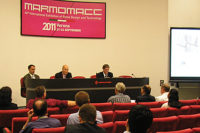
During Marmomacc, leaders from many of the world’s stone associations,
federations and publications gathered to meet and discuss the development of a
green certification standard for natural stone. Photo courtesy of Marmomacc
During Marmomacc, the most important stone show in the world, an equally important event took place. Leaders from many of the world’s stone associations, federations, and publications gathered to meet and discuss the development of a green certification standard for natural stone. Sebastiano Brancoli, representing VeronaFiere, kicked off the meeting, reminding attendees of the continued efforts on this topic which had begun last year. “A standard certification system is needed so that architects understand and trust that it is clean,” he said.
John Mattke, President of Cold Spring Granite, then took the reins to provide a short history of the Natural Stone Council (NSC) and reviewed the goals to educate and inform the industry about the role of the environment in their activities and priorities. “Within 18 to 24 months, there will be a U.S. Green Building Council standard to be adhered to,” he said.
Mattke formally introduced the main speakers and representatives of the NSC, and asked attendees to offer up a short statement of the current efforts and interest in sustainability within their organizations. Most commented that they were focused on a variety of efforts, including a comparative research analysis of stone to materials such as glass; participating in the development and refinement of programs that are similar to LEED such as BREEAM and Green Guide in the U.K.; and the development of Environmental Product Declarations (EPDs), which are underway in Europe. Additionally, general concern for the environment is evident as attendees understand the impact that population growth and the demand for development are having on resources.
Jack Geibig, President of EcoForm, proceeded with an overview of the development of the proposed green certification standard for natural stone. The standard process began in response to the growing green building market and regulatory environment in the U.S. Programs such as the U.S. Green Building Council’s Leadership in Energy and Environmental Design (LEED), Green Globes and others have made it absolutely essential for future market success to have such a label for stone. The certification standard process will be run in accordance with ANSI standards with support and cooperation from the National Sanitation Foundation (NSF). The development of the standard is expected to take between 18 and 20 months and will entail a variety of committee meetings and reviews through a multi-stakeholder process with the intent of developing criteria and performing technical research. Geibig sought the input and interest of the attendees to join the effort and participate in the process. He also clarified for the attendees the difference between such a standard and an EPD, which do not make a value judgment. Other comments raised included the concern over a variety of different programs being developed instead of one coordinated method for creating sustainable buildings and environments. Geibig reminded the attendees that they could all benefit from the development of the standard as it will establish a set of well-defined environmental and human health metrics that are recognized by the green building movement as an indicator of leadership in sustainability performance. The standard also has the potential to harmonize national and international environmental requirements for stone quarrying and production as well as create parity and a competitive edge for the stone industry as a whole.
“The misinformation out there is countered by data,” Geibig said. “A benchmarking study is being done with 40 granite quarries and 26 processing facilities to determine industry best practices in terms of waste management, transportation, site maintenance and closure and water consumption, treatment and re-use.”
By establishing a public standard, the stone industry can offset the negative publicity campaigns of alternative products. “The best defense is the offense of creating a standard that can be third-party verified, that is transparent and shows that the industry is doing the right things to establish the stone industry as an environmental player,” Geibig said.
Gary Distelhorst, Executive Vice President of the Marble Institute of America (MIA), provided an overview of the financial implications of the stone certification process and formally solicited support for the effort. “Funding has to come from the industry - companies and associations,” he said. “We need the support of stone companies around the world. We need financial resources as well as help in developing standards. We need money to bring it to market - to architects and designers - and we invite the support and involvement of the industry.”
Final discussions centered on coordinating communications and collaborating at an informational and educational level. Sharing of attendee information will be circulated so that the group can continue to discuss, coordinate and participate in the standard process as it moves forward. The joint committee is nearly formed and there will be an initial teleconference, followed up shortly by a face-to-face meeting to begin the standards development process in earnest. For the standard to truly have international recognition and influence, support and input from all the organizations and representatives of natural stone around the world is critical. So it is the intention of the NSC to reach out further to those who did not participate in the meeting while continuing to build on the relationships that have already been established through regular communications and in-person meetings on the subject of stone and sustainability in the coming months. To learn more about the stone standard process and to get involved, contact Jack Geibig at jgeibig@ecoform.com or visit www.genuinestone.com.
Natural Stone Certification Program Fact Sheet courtesy of the Natural Stone Council
Sustainability has emerged as the seminal issue of this decade, both in the U.S. and globally. Unstable global energy supplies, international scientific and political debates over climate change and increased emphasis on life cycle-based policy setting have provided the background for the continued and strengthening focus on sustainability within the public discourse. Despite the backdrop of severe economic recession, nowhere has the effect of this been felt more dramatically than in the building sector, as exemplified by the evolution of green building policies and rating programs, and new and emerging green products and continued demand and growth in the number of Leadership in Energy and Environmental Design (LEED)-rated buildings.The Natural Stone Council (NSC) and its members in the natural stone industry continue to be a part of this effort. Over the last three years, the NSC and the industry have worked to characterize and ultimately improve the overall sustainability of its members’ operations and the products they manufacture. In partnership with the Center for Clean Products at the University of Tennessee, the NSC conducted a comprehensive benchmarking of industry operations, identified and communicated best practices, made industry and product environmental data publicly available and evaluated stone cladding products against alternatives using a life-cycle framework. Through these efforts, the industry has gained valuable understanding about the environmental strengths and liabilities of stone relative to other materials, developed strategic goals for improvement, and gained valuable insight required to effectively position stone in the evolving green building movement.
These essential efforts are the foundation for the next phase of work. Members of the NSC and the dimensional stone industry announced the development and launch of an international certification program for dimensional stone products, which began in September 2010.
Benefits to the stone industry of a stone standard
Building a credible certification program for stone will require both the development of robust standards through American National Standards Institute (ANSI) and the formation of a credible compliance and verification system. When completed, such a system will:- Establish a set of well-defined environmental and human health metrics recognized by the green building movement as an indicator of leadership in sustainability performance.
- Provide an important opportunity to educate key members of the green building movement, government and environmental advocacy groups about the production of stone products.
- Create a mechanism that rewards natural stone companies that demonstrate environmental leadership through commitment to sustainable operations and continued innovation.
- Preempt competitor marketing claims by proactively addressing potential stone-related environmental and human health concerns in a multi-stakeholder, science-based forum (i.e. radon, dust, etc.).
- Harmonize national and international environmental requirements for stone quarrying and production.
- Create parity and a competitive edge between stone and other competitive products covered by existing certification programs.





